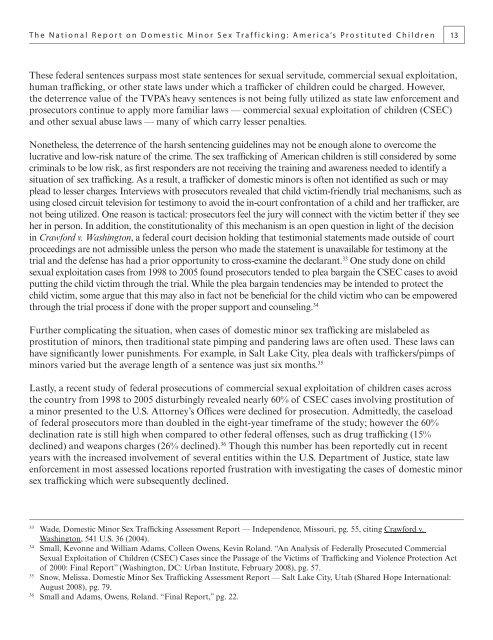By Linda A Smith Samantha Healy Vardaman Melissa A Snow
The National Report on Domestic Minor Sex Trafficking
The National Report on Domestic Minor Sex Trafficking
You also want an ePaper? Increase the reach of your titles
YUMPU automatically turns print PDFs into web optimized ePapers that Google loves.
The National Report on Domestic Minor Sex Trafficking: America’s Prostituted Children 13These federal sentences surpass most state sentences for sexual servitude, commercial sexual exploitation,human trafficking, or other state laws under which a trafficker of children could be charged. However,the deterrence value of the TVPA’s heavy sentences is not being fully utilized as state law enforcement andprosecutors continue to apply more familiar laws — commercial sexual exploitation of children (CSEC)and other sexual abuse laws — many of which carry lesser penalties.Nonetheless, the deterrence of the harsh sentencing guidelines may not be enough alone to overcome thelucrative and low-risk nature of the crime. The sex trafficking of American children is still considered by somecriminals to be low risk, as first responders are not receiving the training and awareness needed to identify asituation of sex trafficking. As a result, a trafficker of domestic minors is often not identified as such or mayplead to lesser charges. Interviews with prosecutors revealed that child victim-friendly trial mechanisms, such asusing closed circuit television for testimony to avoid the in-court confrontation of a child and her trafficker, arenot being utilized. One reason is tactical: prosecutors feel the jury will connect with the victim better if they seeher in person. In addition, the constitutionality of this mechanism is an open question in light of the decisionin Crawford v. Washington, a federal court decision holding that testimonial statements made outside of courtproceedings are not admissible unless the person who made the statement is unavailable for testimony at thetrial and the defense has had a prior opportunity to cross-examine the declarant. 33 One study done on childsexual exploitation cases from 1998 to 2005 found prosecutors tended to plea bargain the CSEC cases to avoidputting the child victim through the trial. While the plea bargain tendencies may be intended to protect thechild victim, some argue that this may also in fact not be beneficial for the child victim who can be empoweredthrough the trial process if done with the proper support and counseling. 34Further complicating the situation, when cases of domestic minor sex trafficking are mislabeled asprostitution of minors, then traditional state pimping and pandering laws are often used. These laws canhave significantly lower punishments. For example, in Salt Lake City, plea deals with traffickers/pimps ofminors varied but the average length of a sentence was just six months. 35Lastly, a recent study of federal prosecutions of commercial sexual exploitation of children cases acrossthe country from 1998 to 2005 disturbingly revealed nearly 60% of CSEC cases involving prostitution ofa minor presented to the U.S. Attorney’s Offices were declined for prosecution. Admittedly, the caseloadof federal prosecutors more than doubled in the eight-year timeframe of the study; however the 60%declination rate is still high when compared to other federal offenses, such as drug trafficking (15%declined) and weapons charges (26% declined). 36 Though this number has been reportedly cut in recentyears with the increased involvement of several entities within the U.S. Department of Justice, state lawenforcement in most assessed locations reported frustration with investigating the cases of domestic minorsex trafficking which were subsequently declined.33Wade, Domestic Minor Sex Trafficking Assessment Report — Independence, Missouri, pg. 55, citing Crawford v.Washington, 541 U.S. 36 (2004).34Small, Kevonne and William Adams, Colleen Owens, Kevin Roland. “An Analysis of Federally Prosecuted CommercialSexual Exploitation of Children (CSEC) Cases since the Passage of the Victims of Trafficking and Violence Protection Actof 2000: Final Report” (Washington, DC: Urban Institute, February 2008), pg. 57.35<strong>Snow</strong>, <strong>Melissa</strong>. Domestic Minor Sex Trafficking Assessment Report — Salt Lake City, Utah (Shared Hope International:August 2008), pg. 79.36Small and Adams, Owens, Roland. “Final Report,” pg. 22.
















